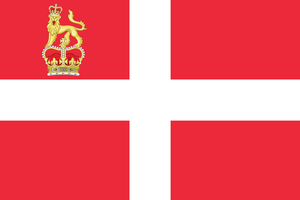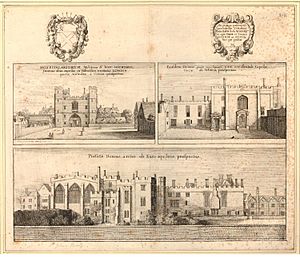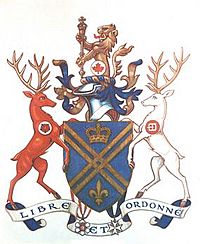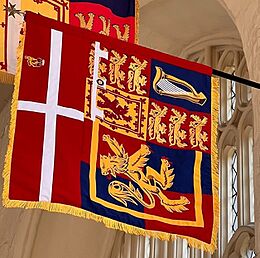Order of Saint John (chartered 1888) facts for kids
Quick facts for kids Most Venerable Order of the Hospital of St John of Jerusalem |
|
|---|---|
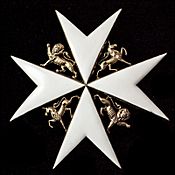
Breast star of a Knight of Grace
of the Order of St John |
|
| Type | Order of chivalry |
| Established | 1888 |
| Motto | Pro Fide Pro Utilitate Hominum |
| Eligibility | Service to the order |
| Status | Extant |
| Sovereign Head | Charles III |
| Grand Prior | The Duke of Gloucester |
| Lord Prior | Mark Compton |
| Grades |
|
| Precedence | |
| Next (higher) | Dependent on State |
| Next (lower) | Dependent on State |
Ribbon of the order |
|
The Most Venerable Order of the Hospital of Saint John of Jerusalem, often called the Order of St John, is a special group of people who work to help others. It was officially started in 1888 by Queen Victoria and is dedicated to St John the Baptist.
This Order has a long history, going back to the Knights Hospitaller from the Middle Ages. These knights were a very old group, first formed in Jerusalem around 1099. They were later known as the Order of Malta. In the 1820s and 1830s, a part of this group moved to Britain. Over time, they became known for starting the St John Ophthalmic Hospital in Jerusalem in 1882 and the St John Ambulance Brigade in 1887.
Today, the Order of St John is active in many countries, including the Commonwealth of Nations, Hong Kong, the Republic of Ireland, and the USA. Its main goal is "to prevent and relieve sickness and injury, and to act to enhance the health and well-being of people anywhere in the world." There are about 25,000 members. Most are Protestant Christians, but people of other Christian groups and other religions are also welcome. You can only join if you are invited.
The Order of St John is most famous for the health organizations it created, like St John Ambulance (which teaches first aid) and the St John Eye Hospital Group (which helps people with eye problems). These organizations help everyone, no matter their religion. The Order is part of a larger group called the Alliance of the Orders of Saint John of Jerusalem. Its main office is in London, and it is a registered charity in England.
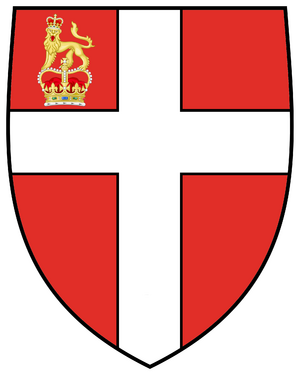
Contents
History of the Order of St John
How the Order Began Again
In the 1820s, some of the old Knights of Malta in France started giving special titles to people in England who supported them.
In 1831, a group in France helped create a new branch of the Order in England. This English group set up its headquarters at St John's Gate, Clerkenwell in London. This place used to be a gatehouse for the old Clerkenwell Priory, which was a medieval home for the original Knights of Saint John. This new English group saw itself as a continuation of the ancient Knights Hospitaller.
The Reverend Sir Robert Peat became the first leader, or Grand Prior, of this English group in 1834. After he passed away in 1837, Sir Henry Dymoke took over. He tried to get the Roman Catholic Sovereign Military Order of Malta to recognize the English group, but they said no. Because of this, the English group decided to be independent and called itself "The Sovereign and Illustrious Order of Saint John of Jerusalem, Anglia." This showed they believed they were the true successors of the 11th-century Order of St John.

Becoming the Modern Order
In 1871, the Order changed its name to the more humble "Order of Saint John of Jerusalem in England." Important people like Princess Alexandra and her husband, Albert Edward, Prince of Wales (who later became King Edward VII), joined the Order.
In 1877, the Order started St John Ambulance associations. These groups taught first aid to railway workers and miners so they could help people injured in accidents. In 1882, they opened an eye hospital in Jerusalem (now the St John of Jerusalem Eye Hospital Group). By 1887, the St John Ambulance Brigade was formed, doing important life-saving work.
The Order was officially recognized by Queen Victoria in 1888 with a royal charter. This charter gave it the name "Grand Priory of the Order of the Hospital of Saint John of Jerusalem in England." The name changed a few times over the years, and in 1961, it joined with other similar groups in Europe to form the Alliance of the Orders of Saint John of Jerusalem. This led to it being recognized by the Order of Malta in 1963. The Order's most recent royal charter was in 1955, and a later one in 1974 gave it its current name, showing its worldwide reach. In 1999, the Order gained special status with the United Nations Economic and Social Council.
How the Order is Organized
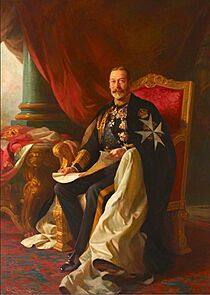
Leaders of the Order
Charles III is the highest leader of the Order of St John, known as its Sovereign Head. Below him is the Grand Prior, who since 1975 has been Prince Richard, Duke of Gloucester.
The Grand Prior works with other important leaders, including the Lord Prior of St John (who helps the Grand Prior), the Prelate (an Anglican bishop), and other deputies and officers. These leaders, along with the heads of the Order's regional groups (called priories), form the Grand Council. This council helps run the Order.
Grand Priors Through History
Since the Order received its Royal Charter in 1888, the Grand Prior has always been a member of the British royal family.
- The Reverend Sir Robert Peat (1831–1837)
- Sir Henry Dymoke (1838–1847)
- Lieutenant Colonel Sir Charles Montolieu Lamb (1847–1860)
- Rear Admiral Sir Alexander Arbuthnott (1860–1861)
- William Montagu, 7th Duke of Manchester (1861–1888)
- Albert Edward, Prince of Wales (1888–1901)
- George, Prince of Wales (1901–1910)
- Prince Arthur, Duke of Connaught and Strathearn (1910–1939)
- Prince Henry, Duke of Gloucester (1939–1974)
- Prince Richard, Duke of Gloucester (1975–present)
Lord Priors Through History
This role was called "Sub Prior" until 1943, then "Prior" until 1950, and "Lord Prior" since then.
- Aldred Lumley, 10th Earl of Scarbrough (1923–1943) - as Sub-prior
- Ivor Windsor-Clive, 2nd Earl of Plymouth (1943) - as Prior
- John Loder, 2nd Baron Wakehurst (1950–1969) - as Lord Prior
- Harold Caccia, Baron Caccia (1969–1981)
- Sir Maurice Dorman (1982–1985)
- Alan Cathcart, 6th Earl Cathcart (1986–1987)
- Ralph Grey, Baron Grey of Naunton (1988–1990)
- Samuel Vestey, 3rd Baron Vestey (1991–2001)
- Colonel Eric Barry (2002–2008)
- Anthony Mellows (2008–2014)
- Neil Conn (2014–2015)
- Sir Malcolm Ross (2016–2019)
- Mark Compton (2019–present)
Membership Levels
Members of the Order are divided into six levels, or "grades," each with special letters they can use after their name.
| Levels of the Order of St John | |||||
|---|---|---|---|---|---|
| Level | Level I | Level II | Level III | Level IV | Level V |
| Title (English) | Bailiff/Dame Grand Cross | Knights/Dames of Justice or Grace | Commander/Chaplain | Officer | Member |
| Post-nominal letters | GCStJ | KStJ/DStJ | CStJ/ChStJ | OStJ | MStJ |
When new Knights and Dames join, the Grand Prior touches their shoulder with a sword. They also receive special robes and badges. While members get special standing within the Order, they don't use "Sir" or "Dame" in their everyday titles. However, they can add symbols of the Order to their personal coat of arms.
The Order also gives out awards like the Life Saving Award and the Service Medal for special achievements.
Regional Groups: Priories and Commanderies
The Order of St John has groups around the world called "Priories" and "Commanderies." These include Priories in England and The Islands, Wales, Scotland, Canada, Australia, New Zealand, South Africa, the United States, Kenya, and Singapore. Each Priory is led by a Prior. Smaller groups called Commanderies exist within or outside these Priories.
In Canada, the Order of St John has a long history, with the first modern branch starting in 1883. Today, it's a part of Canada's national honours system, and the Canadian Priory is one of the largest outside the UK, with about 6,000 members. The Governor General leads the Order in Canada.
In the United States, a group was formed in 1957 to help the Order's charity work, especially the St John Ophthalmic Hospital in Jerusalem. This group grew, and in 1996, Queen Elizabeth II officially created the Priory of the United States of America. American members promise to be loyal to the Order as long as it doesn't conflict with their duty to their own country.
Special Clothes and Badges
When people join the Order of St John, they receive special badges and robes to wear for important events. The main badge for all members is an eight-pointed Maltese Cross. It has two lions and two unicorns in the corners.
| Badges of the Order of St John | ||||||
|---|---|---|---|---|---|---|
| Level | Bailiffs/Dames Grand Cross | Knights/Dames of Justice | Knights/Dames of Grace | Commanders | Officers | Members |
| Badge |  |
 |
 |
 |
 |
|
| Size | 82.5 mm 57.2 mm suspended |
57.2 mm | 44.4 mm | |||
| Material | Enamel | Silver | ||||
| Backing and decorations |
Gold | Silver | ||||
The Sovereign Head's badge is gold with white enamel and jewels, topped with a crown. Other leaders have similar badges with different crowns or symbols. Members wear their badges in different ways: some on a wide ribbon over the shoulder, others on a ribbon around the neck, or on a smaller ribbon pinned to the chest.
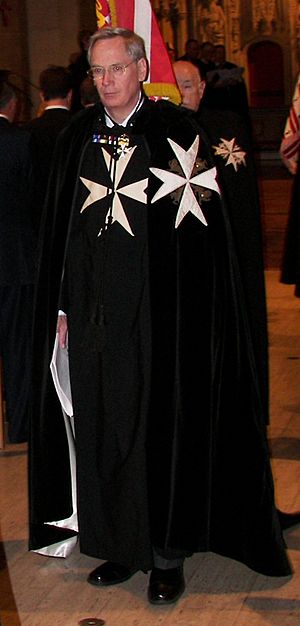
For formal events, members wear special robes, including a long cloak called a mantle, a long black gown called a sopra vest, and a special hat. The mantles are usually black silk or wool and have a white silk star of the Order on the left side. The size of the star depends on the member's level.
How to Join the Order
The Sovereign Head decides who joins the Order. There's a limit of 35,000 members, and you must be at least 18 years old. People are usually chosen because they have shown kindness and helped others, especially those who are sick, suffering, or in danger. This reflects the Order's mottos: Pro Fide (For the Faith) and Pro Utilitate Hominum (For the Service of Humanity).
When new members join, they say a special promise:
I promise to be loyal to The Order of St John and its Sovereign Head, as long as it agrees with my duty to my country. I will do my best to support its good work and always act with honor.
Christian members also say:
I promise that I believe in God the Father, God the Son, and God the Holy Spirit.
Even though the Order has Christian values, since 1999, you don't have to be Christian to join. The Order believes in helping everyone, no matter their faith. They welcome people from different religions, focusing on their acts of kindness and service.
Order of Wear for Medals
Joining the Order of St John does not give you a special social title or rank outside the Order itself. Where its medals are worn compared to other awards depends on the country. For example:
| Country | Worn After | Worn Before |
|---|---|---|
| Medal of the Order of Australia | Distinguished Conduct Medal (if awarded before 1992) Conspicuous Service Medal |
|
| Member of the Royal Victorian Order | Grand Officer of the National Order of Quebec | |
| Royal Red Cross (Class II) | Distinguished Conduct Medal | |
Current Bailiffs and Dames Grand Cross
- Sovereign Head: King Charles III
- Grand Prior: Prince Richard, Duke of Gloucester KG GCVO GCStJ, appointed Grand Prior and Bailiff Grand Cross in 1975
- Bailiffs and Dames Grand Cross
| Name | Post-nominals | Year appointed |
|---|---|---|
| Queen Noor of Jordan | GCStJ | 1989 |
| Sir Norman Lloyd-Edwards | KCVO, GCStJ, JP, RD | 1996 |
| John Strachan | GCStJ | 1997 |
| Professor Villis Marshall | AC, GCStJ | 1999 |
| Lady Elizabeth Godsal | MBE, GCStJ, DL | 2000 |
| Audrey, Baroness Emerton | DBE, GCStJ, FRCN | 2004 |
| Neville Byron Darrow | GCStJ | 2005 |
| Bishop Jack Nicholls | GCStJ | 2007 |
| Anthony Hugh Chignell | MBE, GCStJ, FRCS | 2008 |
| The Princess Royal | KG, KT, GCVO, GCStJ, QSO, CMM, ADC(P) | 2009 |
| Brigadier John Hemsley | OBE, GCStJ | |
| Lieutenant-Colonel John Mah | GCStJ, CD, KC | |
| Major Ian Crowther | MBE, GCStJ | 2010 |
| John Rozet Drexel IV | GCStJ | |
| Richard Bruce | MOM, GCStJ | 2011 |
| The Hon. Dr Neil Conn | AO, GCStJ | 2012 |
| Stuart Shilson | LVO, GCStJ, DL | 2013 |
| Judith Ann Hoban | GCStJ | |
| Patrick Burgess | MBE, GCStJ, DL | 2014 |
| Major-General Professor John Pearn | AO, GCStJ, RFD | |
| Marshall Acuff Jr. | GCStJ, CFA | |
| Dr Low Bin Tick | OBE, GCStJ, JP | |
| Bishop Tim Stevens | CBE, GCStJ | 2016 |
| Fiona, the Hon. Lady Barttelot | MBE, GCStJ, DL | 2017 |
| Professor Mark Compton | AM, GCStJ | |
| Major Marsden Madoka | OBE, GCStJ | 2020 |
| Dr Gillian Boughton-Willmore | GCStJ, FRSA | |
| Brigadier General / Professor Deon Fourie | SD, MMM, GCStJ | 2021 |
| Dr Steven Evans | GCStJ, FRCP | |
| Robert Hector White | GCStJ | 2022 |
| The Duchess of Edinburgh | GCVO, GCStJ, CD | |
| Ann Elizabeth Cable | MBE, GCStJ, DL | 2023 |
| Thomas Matthew Budd | GCStJ | |
| Cameron Oxley | 2024 | |
| Sir David Hempleman-Adams | KCVO, OBE, GCStJ, DL | 2025 |
| Stuart Waetzel | GCStJ | 2025 |
| Archbishop Sir David Moxon | KNZM, GCStJ | 2025 |
| Dr Michel C Doré | GCStJ | 2025 |
More About the Order
- Service Medal of the Order of St John
- Donat of the Order of Saint John
- Sovereign Military Order of Malta
- List of the priors of Saint John of Jerusalem in England
- List of bailiffs and dames grand cross of the Order of St John
- Order of Saint John (Bailiwick of Brandenburg)
- Museum of the Order of St John
See also
 In Spanish: Venerable Orden de San Juan para niños
In Spanish: Venerable Orden de San Juan para niños


